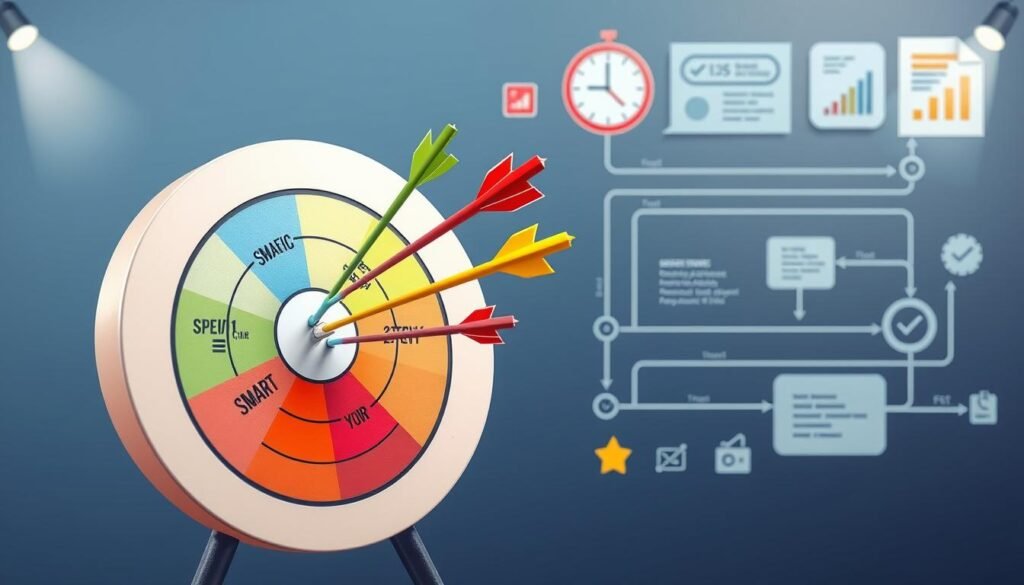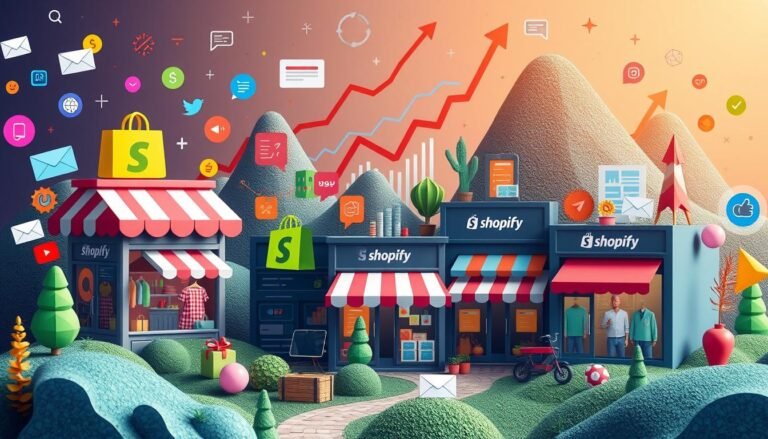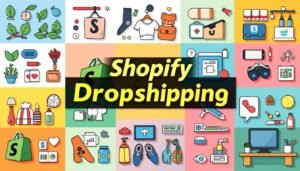In today’s competitive ecommerce world, a good marketing plan is key. As a Shopify owner, I’ve found that the right digital marketing can really help. It can increase your reach, engagement, and profits.
About 87% of successful eCommerce businesses say their growth came from smart marketing. Those who use full marketing plans see a 32% boost in sales. Working with clients on marketing plans leads to 22% better results. Using data and analytics can raise your ROI by 27%.
In this article, I’ll share top tips to boost your Shopify marketing. We’ll talk about knowing your audience, making your store better for sales, and more. These strategies can help your business grow.
Key Takeaways
- Developing a comprehensive marketing strategy can increase ecommerce conversion rates by up to 32%.
- Leveraging data and analytics in your marketing tactics can improve ROI by 27%.
- Effective Shopify marketing combines various digital channels, including social media, email, and SEO.
- Personalized content and customer experience can boost engagement and loyalty.
- Continuously testing and optimizing your marketing efforts is crucial for long-term success.
What is a Marketing Strategy?
A marketing strategy is a detailed plan for your business. It outlines your goals, who you want to reach, and how you’ll do it. It’s the base of all your marketing, helping you find and connect with customers.
Defining a Marketing Strategy
A marketing strategy definition has four main parts:
- Your unique value proposition: What makes your products or services different and better than others?
- Market research: Knowing your target audience, their needs, and how they buy things.
- Messaging and branding: Creating a story and messages that speak to your audience.
- Marketing channels: Choosing the best ways to reach and talk to your audience, like social media or email.
Benefits of a Marketing Strategy
Having an ecommerce marketing strategy brings many benefits to your Shopify store, including:
- Increased brand awareness and visibility: A good strategy helps you be seen more in a busy online world.
- Improved customer engagement and loyalty: Knowing your audience and tailoring your messages builds stronger customer bonds.
- More efficient use of marketing resources: A strategic plan helps you use your time, money, and effort wisely.
- Measurable results and data-driven decisions: You can set measurable marketing goals and track your success, guiding your decisions.
In short, a solid marketing strategy is key for your Shopify store’s success. It helps you reach your audience, stand out, and meet your goals.

Conduct Market Research
Doing target audience research and competitive analysis is key for your Shopify store’s success. Knowing your customers and competitors helps you make a marketing plan that stands out. It also connects with the right people.
Understanding Your Target Audience
Your ecommerce target audience is who you want to sell to. You can find out who they are by using surveys, interviews, and website data. This helps you make a buyer persona.
This persona guides your marketing efforts. It helps you reach your customers more effectively.
Competitive Analysis
Doing a competitive analysis for ecommerce gives you important insights. You learn about their audience, marketing, and products. This shows you where you can be different.
When looking at competitor research for Shopify, check their social media, branding, and prices. Also, look at customer feedback and what makes them special.
Knowing your audience and competitors helps you make a strong marketing strategy. This strategy will help your Shopify store succeed.

“The more you understand your customers, the better you can serve them.” – Peter Drucker
Define Product-Market Fit
Getting a clear product-market fit is key for your Shopify store’s success. It means knowing why you sell what you do and how it helps your customers. Good messaging shows your unique value and connects with your audience.
Experts say product-market fit means your product really solves customer problems. Businesses that get it grow faster and longer than those that don’t. For example, Hero Packaging found success with eco-friendly shipping. Parade made underwear that’s inclusive and sustainable.
“Achieving product-market fit can lead to increased customer base and sales through organic marketing or word of mouth.”
To find your Shopify product-market fit, know your audience’s pain points. See how your products solve them. Use feedback to improve your products. Watch customer retention and sales growth to see how you’re doing.
Aligning your products with what your customers want unlocks your store’s full potential. Aim for a clear product-market fit for ecommerce.
Set Measurable Marketing Goals
Setting clear marketing goals is key to success in ecommerce. Use the SMART goal framework to make goals Specific, Measurable, Achievable, Relevant, and Time-bound. This helps keep your marketing focused and on track with your business goals.
The SMART Goal Framework
The SMART goal framework helps set SMART marketing goals that lead to real results. Let’s break down the main parts:
- Specific: Goals should be clear, like “Increase website traffic by 20% in 3 months.”
- Measurable: Use numbers like sales or followers to see how you’re doing.
- Achievable: Goals should challenge your team but be doable with your resources.
- Relevant: Make sure goals match your business goals and marketing plan.
- Time-bound: Set a specific time to reach your goals, like “Grow email list by 500 in 6 weeks.”
Using the SMART framework helps you set ecommerce marketing goals that are clear and achievable. This makes your goals exciting to work towards, not vague or impossible.
| Metric | Current Value | Goal | Timeframe |
|---|---|---|---|
| Website Traffic | 5,000 visits/month | 6,000 visits/month | 3 months |
| Email List Size | 1,200 subscribers | 1,700 subscribers | 2 months |
| Social Media Followers | 2,500 followers | 3,000 followers | 1 quarter |

“Setting good marketing objectives can help outline the business’s best path to success.”
Explore Marketing Channels
As an ecommerce business owner, you have many marketing channels to reach customers. You can use social media or search engine optimization (SEO). Each channel has its own way to attract your audience and bring traffic to your Shopify store.
Social Media Marketing
Social media like TikTok, Instagram, Facebook, and Twitter are great for social media marketing for Shopify. You can make engaging content and use these platforms’ features. This helps build your brand, connect with people, and increase sales. A good Shopify social media strategy can make your social media work better.
Search Engine Marketing
Google is where most people find websites. Making your Shopify store better for Shopify SEO can attract people looking for what you sell. You need to work on website speed, make it mobile-friendly, and post new content. This boosts your search engine marketing for ecommerce.
| Marketing Channel | Advantages | Disadvantages |
|---|---|---|
| Social Media |
|
|
| Search Engine Marketing |
|
|
By choosing the right marketing channels, you can reach more people, engage your audience, and grow your Shopify store.

Shopify Marketing Strategies
As a Shopify store owner, making your online store better is key. You should work on making more sales and using social media well.
Optimize Your Shopify Store for Conversion
Make your online store welcoming and easy to use. Use popups to get leads and banners for sales. Also, make sure your store looks good and works well.
Good reviews are very important. They show people trust you. 94% of shoppers like to buy from places with good reviews.
Leverage the Power of Social Media
Being on different social media sites helps you reach more people. Sites like TikTok, Instagram, Facebook, and X have videos, posts, and images. These can grab your audience’s attention.
Watch how your social media does and change your plan if needed. This way, you can reach your audience better.
Using these strategies can make your online store better. You’ll connect with your audience in a stronger way.
Email Marketing Campaigns
Email marketing is key for reaching customers and keeping them engaged. It helps new leads become customers by sending updates and special offers. For current customers, it boosts engagement and encourages more buys with new product news and discounts.
Nurturing New Leads
Shopify makes email marketing easy for new customers. You get a free trial and many email templates. It helps you send emails that build trust and encourage first buys.
Engaging Existing Customers
Keeping current customers happy is just as important as getting new ones. Shopify email marketing has many tools to keep your brand in mind. Features like automated emails and special offers help keep customers coming back.
| Feature | Benefit |
|---|---|
| 10,000 free emails per month | Cost-effective way to launch customer retention email marketing campaigns |
| Automated email flows | Nurture leads and re-engage customers without manual effort |
| Personalized product recommendations | Increase relevance and drive higher conversion rates for Shopify email campaigns |
| Integrated multimedia content | Enhance customer engagement and brand loyalty |

“Email marketing remains a powerful tool for reaching customers directly and nurturing them through the customer journey.”
Enhance Customer Experience
It’s key to make customers happy and keep them coming back. Ecommerce personalization helps a lot. It makes shopping feel just right for each person. Using customer data for special product picks and Shopify customer self-service makes shopping better and boosts sales.
Personalization
Personalization makes shopping more fun and memorable. Shopify stores can use data to suggest products and content just for you. This makes customers happier and more likely to buy more.
Customer Self-Service
Ecommerce self-service features like chatbots help a lot. They give quick help without needing a person. This makes customers happy and helps your team do more important things. It makes shopping easier and more fun.
“Customer experience improvement has seen a 19 percentage point increase in priority from 2019 to 2022, according to research from McKinsey & Company.”
For success in ecommerce, a great customer experience is key. Personalization and self-service help Shopify stores stand out. They build strong customer bonds and grow their business.
Search Engine Optimization (SEO)
In the world of ecommerce, SEO is key for Shopify store owners. It helps bring in the right customers and boost sales. By optimizing your store, you become a trusted name in your field.
Shopify has many SEO tools to help your store. It has features like sitemaps and mobile-friendly themes. But, to really shine, you need to learn more about Shopify SEO.
Technical SEO Optimization
First, make sure your Shopify store is technically sound. This means fast loading times and easy navigation. Shopify’s Dawn theme helps make your site user-friendly for everyone.
Keyword Research and Content Optimization
Finding the right keywords is vital for Shopify SEO. Do deep research to see what your customers are searching for. Then, make your content SEO-friendly and engaging.
Off-Site SEO Strategies
Off-site SEO is also important. Get other websites to link to your store. This shows search engines your content is valuable.
With Shopify SEO, your online business can grow. Focus on technical optimization, content, and off-site promotion. A good SEO plan can bring in more customers and make your store a leader.
Implement Loyalty Programs
Starting a loyalty program can really thank and keep customers coming back. It works by giving points for each buy. These points can get you discounts or special deals. Having different levels and special perks makes being loyal even better.
Studies show 70% of US shoppers like loyalty programs. Also, 60% want discounts for joining. And 33% like getting early access to new products.
Shopify stores like Blume and LIVELY use loyalty programs well. Blume gives Blume Bucks for social media and orders. LIVELY has points for fun activities, with levels based on how much you spend.
Mirenesse and 100% Pure also have great programs. Mirenesse has Gold and Onyx levels with free shipping and points. 100% Pure has levels for spending, with perks like early access and free shipping.
Shopify apps like Smile or Yotpo make it easy to start a loyalty program. With a good Shopify loyalty program, you can keep customers happy and grow your business.
| Program | Rewards | Benefits |
|---|---|---|
| Blume Blumetopia | Blume Bucks | Earned through social media, orders, and referrals |
| LIVELY Rewards | Points | Tiered program based on annual spend |
| Mirenesse Love Rewards | Gold and Onyx tiers | Free shipping, point conversions, and joining bonuses |
| 100% Pure Rewards | Tiered system | Early access, free shipping, and redeemable vouchers |
“Creating a loyalty program online with apps like Smile or Yotpo from the Shopify App Store can enhance customer engagement and loyalty.”
Upselling and Cross-selling
Adding Shopify upselling and cross-selling to your store can really help. It can make your sales go up and keep customers coming back. By offering better products or things that go with what they bought, you can grow a lot.
Upselling means getting customers to buy something more expensive or better. This makes them happy and can make you more money. Amazon makes a lot of money from cross-selling, like when it shows “Customers who bought this item also bought”.
Cross-selling is when you suggest things that go well with what they bought. It’s like when you see pop-ups after you buy something, offering more stuff at a discount. By finding things that go together, you can make customers buy more, which is good for you.
| Shopify Upselling | Shopify Cross-Selling |
|---|---|
| Encourages customers to upgrade to a premium or more feature-rich version of the initial product | Suggests complementary products that can enhance the customer’s experience or solve additional needs |
| Increases the overall transaction value | Boosts the average order value by encouraging customers to add more items to their cart |
| Provides customers with a more tailored and satisfying shopping experience | Should improve customer satisfaction; best practices include recommending necessary accessories, bundling related products, offering discounts on bundles, demonstrating product compatibility, and addressing customer objections |
To really make upselling and cross-selling work, make the shopping experience personal. Listen to what customers might be worried about and make it easy for them to agree. This way, you can make your Shopify store the best it can be and grow your business.
“Cross-selling can be implemented in various industries, such as electronics retail, fast-food restaurants, online stores, car dealerships, and clothing retail.”
Conclusion
Creating a good Shopify marketing plan is key for any online store’s success. Start by learning about your market and what your product offers. Then, set clear goals to guide your actions.
Use many marketing ways like social media and email to reach more people. This helps your brand grow and your store do well.
The online shopping world keeps changing. So, always check and update your marketing plans. This keeps them working well and helps your store grow.
With over 4.6 million active Shopify stores, it’s clear many trust the platform. A strong marketing plan can help your business succeed and stand out online.
FAQ
What is a marketing strategy?
A marketing strategy is a plan for reaching customers. It includes the 4 P’s: Price, Product, Promotion, and Place.
What are the benefits of having a marketing strategy?
A good strategy helps you connect with your audience. It makes you stand out and builds a strong brand. It also helps you plan for the future and use your time and money wisely.
How do I conduct market research for my Shopify store?
Start by learning about your target market. Do research like analyzing competitors and using website analytics. Also, talk to people and read industry reports. This helps you know who to market to best.
Why is defining a product-market fit important for my Shopify store?
Knowing your product-market fit is key to success. It answers questions like: Why do you sell what you do? What problem does it solve? What makes it better than others? Good messaging shows your unique value to your audience.
How do I set measurable marketing goals for my Shopify store?
Setting clear goals is the first step in a good strategy. Use the SMART goal framework. This makes your goals specific, measurable, achievable, relevant, and timely. This way, your goals are clear and reachable.
What are the key marketing channels I should explore for my Shopify store?
Social media is great for connecting with people. SEO helps you reach those searching for what you offer. Email marketing is also powerful for direct communication and nurturing customers.
How can I optimize my Shopify store for conversions?
Make your store inviting and easy to use. Use popups to get leads and banners for sales. A good design encourages more visits and sales.
How can I leverage social media to drive traffic to my Shopify store?
Use different social media content like videos and images. Platforms like TikTok and Instagram help you reach your audience. Choose the ones that fit your brand best.
How can email marketing help me retain and engage my Shopify customers?
Email marketing keeps customers interested and coming back. Send updates and special offers. This keeps your brand in mind and builds loyalty.
How can I enhance the customer experience on my Shopify store?
A great customer experience builds loyalty. Personalize the shopping experience to meet customer needs. Features like chatbots improve the experience too.
How can I optimize my Shopify store for search engines?
Make your store easy for search engines to find. Focus on website speed, mobile use, and clear navigation. Also, post new, SEO-friendly content regularly.
How can a loyalty program benefit my Shopify store?
A good loyalty program rewards customers. Use a points system for discounts and special offers. This motivates customers to keep coming back.
How can upselling and cross-selling help increase my Shopify store’s revenue?
Upselling and cross-selling increase average order value. Upselling offers better versions of products. Cross-selling suggests related products. Both boost sales and customer satisfaction.







